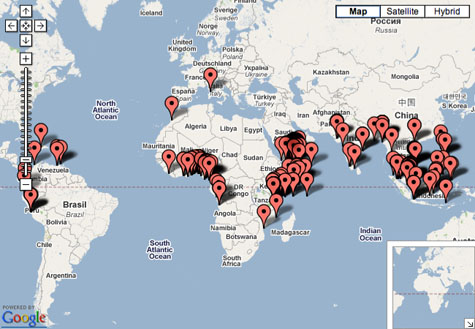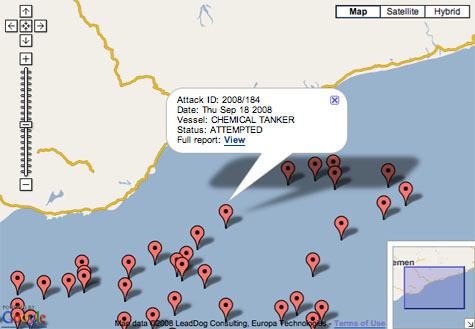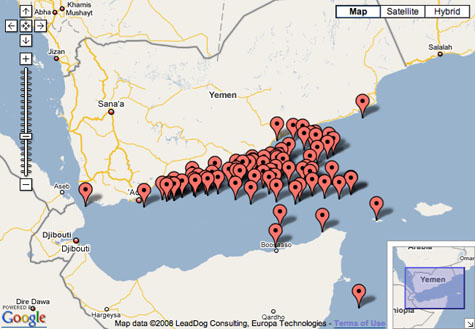 [Image: A screen-grab of the Live Piracy Map].
[Image: A screen-grab of the Live Piracy Map].
With all the talk of piracy at sea, it was only a matter of time before the Live Piracy Map was developed. According to its creators, the map “shows all the piracy and armed robbery incidents reported to the IMB Piracy Reporting Centre during 2008.”
It’s the geography of aquatic crime, mapping realtime adventures in buoyant larceny.
 [Image: From the Live Piracy Map].
[Image: From the Live Piracy Map].
This incident report corresponds to the map, above. The report describes the attempted hijacking of a chemical tanker:
Two white hull boats with several persons onboard approached aggressively a chemical tanker underway with intent to board. Master raised alarm, increased speed, took evasive manoeuvres and contacted coalition forces. SSAS activated and crew mustered. The boats keep on following and at 0700 UTC, the boats aborted the attempt.
These incident reports should be rewritten and assembled somewhere to form a new minor literature of the 21st-century sea; like Félix Fénéon’s awesome Novels in Three Lines, each report will be a small masterpiece of plotting, set in the tidal landscapes of a feral coast. There will be heroes and antiheroes, evasions and threats.
 [Image: From the Live Piracy Map].
[Image: From the Live Piracy Map].
Until then, just look up your favorite maritime hijacking via the Live Piracy Map – and wait till the next incident pops up.
(Via Alexis Madrigal).
It’s kind of scary to see the Pirates becoming more bolder. First the arms ship then the oil tanker. What next? A cruise ship full of people!?
Novels in 3 Lines is amazing. Brief, morbidly romantic, poetic news reports detailing love, murder, and madness. And its available on Twitter. What more could you ask for in literature?
Are pirates just capitalizing on popular internet memes? Is there also a looming outbreak of ninja attacks?
After a fully laden Saudi supertanker is hijacked, mainstream media is finally starting to recognize the severity of this problem. Today’s Wall Street Journal had 3 Section A articles/editorials and a separate blog post on the recent increased piracy in the Middle East.
Pirates off the east coast of Africa are now forcing owners to send their ships all the way around the Cape of Good Hope (South Africa) instead of transiting the Suez Canal. You don’t have to be a navigation officer to figure out that the cost of this deviation is huge. Professional mariners are risking life and limb to keep commerce flowing through this part of the world.
Somali pirates are basically petty thieves with big guns but there’s not much an unarmed ship’s crew can do to defend itself from this type of attack. While it is a huge area to monitor and try to protect, it’s shameful that the international community cannot find a solution.
Thanks for raising the awareness of this problem to a wider community through BLDGBLOG.
Fair Winds,
Peter A. Mello
http://sea-fever.org
http://messingaboutinships.com (podcast)
To revisit the root causes of this piracy thing off the coast of Somalia, the petty thieves Peter mentioned were local fishermen muscled out of their turf and livelihood by bigger fishing trawlers (and some times whole fishing fleets) taking advantage of the lawlessness nature of the failed state known as Somalia.
After successfully hijacking and getting ransom from the owners of these fishing trawlers, these “petty thieves” figured out piracy is way more profitable than fishing and moved to better and bigger targets.
It’s estimated that 30 Million dollars were paid to free up ships this year alone.
Now, the international community is reluctant to intervene at this time for reasons unknown, but surely someone could have stopped the Oil Tanker in the high seas before it got closer to the coast where the pirates get supplies.
Hi,
I guess it was yesterday that this subject was being lightly discussed on the radio and it seems that these pirates are seen as “heroes” and since they have lots of money – they have really good resources – people don’t mind having their daughters married with them, so it seems.
Best regards,
José
Hi, this is a fantastic map! I am currently working on a research project with a view to drafting a joint agreement between shipping companies, governments and NGOs.
There will be more to come on my blog at:
http://www.incorpolis.blogspot.com/
Best regards,
Lucas
Jim Murray
Check out Nemesis5000.com. This has got to be the most effective non lethal answer to armed attacks by scared criminals.